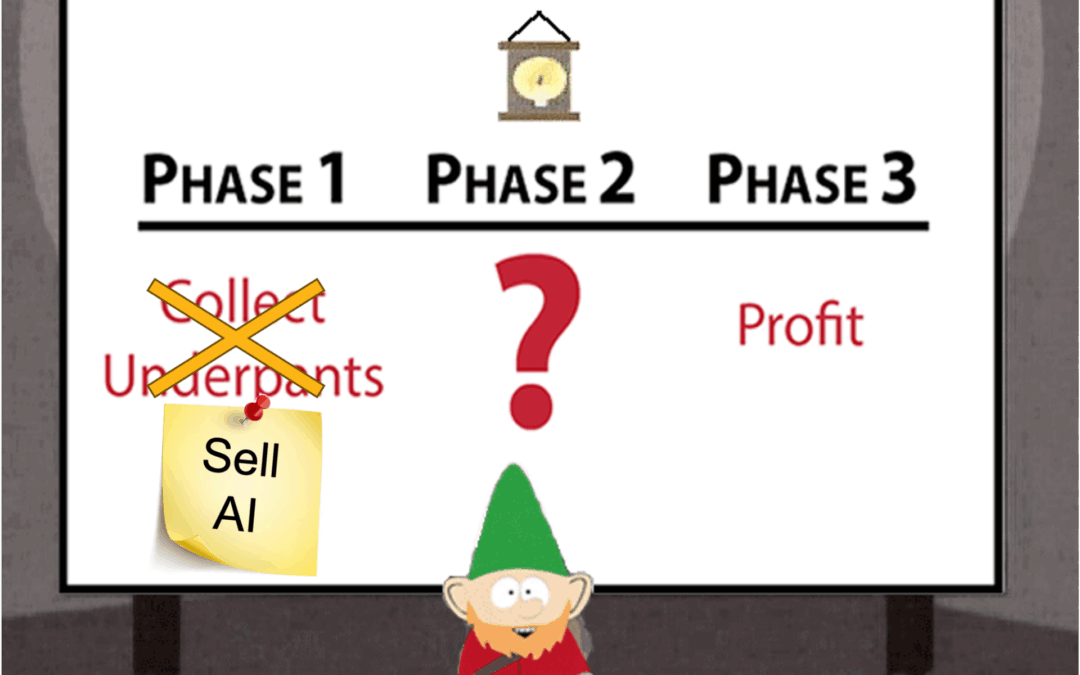
by Robyn Bolton | Dec 2, 2025 | AI
“It just popped up one day. Who knows how long they worked on it or how many of millions were spent. They told us to think of it as ChatGPT but trained on everything our company has ever done so we can ask it anything and get an answer immediately.”
The words my client was using to describe her company’s new AI Chatbot made it sound like a miracle. Her tone said something else completely.
“It sounds helpful,” I offered. “Have you tried it?”
“I’m not training my replacement! And I’m not going to train my R&D, Supply Chain, Customer Insights, or Finance colleagues’ replacements either. And I’m not alone. I don’t think anyone’s using it because the company just announced they’re tracking usage and, if we don’t use it daily, that will be reflected in our performance reviews.”
All I could do was sigh. The Underpants Gnomes have struck again.
Who are the Underpants Gnomes?
The Underpants Gnomes are the stars of a 1998 South Park episode described by media critic Paul Cantor as, “the most fully developed defense of capitalism ever produced.”
Claiming to be business experts, the Underpants Gnomes sneak into South Park residents’ homes every night and steal their underpants. When confronted by the boy in their underground lair, the Gnomes explain their business plan:
- Collect underpants
- ?
- Profit
It was meant as satire.
Some took it as a an abbreviated MBA.
How to Spot the Underpants AI Gnomes
As the AI hype grows, fueling executive FOMO (Fear of Missing Out), the Underpants Gnomes, cleverly disguised as experts, entrepreneurs and consultants, saw their opportunity.
- Sell AI
- ?
- Profit
While they’ve pivoted their business focus, they haven’t improved their operations so the Underpants AI Gnomes as still easy to spot:
- Investment without Intention: Is your company investing in AI because it’s “essential to future-proofing the business?” That sounds good but if your company can’t explain the future it’s proofing itself against and how AI builds a moat or a life preserver in that future, it’s a sign that the Gnomes are in the building.
- Switches, not Solutions: If your company thinks that AI adoption is as “easy as turning on Copilot” or “installing a custom GPT chatbot, the Gnomes are gaining traction. AI is a tool and you need to teach people how to use tools, build processes to support the change, and demonstrate the benefit.
- Activity without Achievement: When MIT published research indicating that 95% of corporate Gen AI pilots were failing, it was a sign of just how deeply the Gnomes have infiltrated companies. Experiments are essential at the start of any new venture but only useful if they generate replicable and scalable learning.
How to defend against the AI Gnomes
Odds are the gnomes are already in your company. But fear not, you can still turn “Phase 2:?” into something that actually leads to “Phase 3: Profit.”
- Start with the end in mind: Be specific about the outcome you are trying to achieve. The answer should be agnostic of AI and tied to business goals.
- Design with people at the center: Achieving your desired outcomes requires rethinking and redesigning existing processes. Strategic creativity like that requires combining people, processes, and technology to achieve and embed.
- Develop with discipline: Just because you can (run a pilot, sign up for a free trial), doesn’t mean you should. Small-scale experiments require the same degree of discipline as multi-million-dollar digital transformations. So, if you can’t articulate what you need to learn and how it contributes to the bigger goal, move on.
AI, in all its forms, is here to stay. But the same doesn’t have to be true for the AI Gnomes.
Have you spotted the Gnomes in your company?

by Robyn Bolton | Nov 1, 2025 | Innovation, Leading Through Uncertainty
“Is this what the dinosaurs did before the asteroid hit?”
That was the first question I was asked at IMPACT, InnoLead’s annual gathering of innovation practitioners, experts, and service providers.
It was also the first of many that provided insight into what’s on innovators and executives’ minds as we prepare for 2026
How can you prevent failure from being weaponized?
This is both a direct quote and a distressing insight into the state of corporate life. The era of “fail fast” is long gone and we’re even nostalgic for the days when we simply feared failure. Now, failure is now a weapon to be used against colleagues.
The answer is neither simple nor quick because it comes down to leadership and culture. Jit Kee Chin, Chief Technology Officer at Suffolk Construction, explained that Suffolk is able to stop the weaponization of failure because its Chairman goes to great lengths to role model a “no fault” culture within the company. “We always ask questions and have conversations before deciding on, judging, or acting on something,” she explained
How do you work with the Core Business to get things launched?
It’s long been innovation gospel that teams focused on anything other than incremental innovation must be separated, managerially and physically, from the core business to avoid being “infected” by the core’s unquestioning adherence to the status quo.
The reality, however, is the creation of Innovation Island, where ideas are created, incubated, and de-risked but remain stuck because they need to be accepted and adopted by the core business to scale.
The answer is as simple as it is effective: get input and feedback during concept development, find a core home and champion as your prototype, and work alongside them as you test and prepare to launch.
How do you organize for innovation?
For most companies, the residents of Innovation Island are a small group of functionally aligned people expected to usher innovations from their earliest stages all the way to launch and revenue-generation.
It may be time to rethink that.
Helen Riley, COO/CFO of Google X, shared that projects start with just one person working part-time until a prototype produces real-world learning. Tom Donaldson, Senior Vice President at the LEGO Group, explained that rather than one team with a large mandate, LEGO uses teams specially created for the type and phase of innovation being worked on.
What are you doing about sustainability?
Honestly, I was surprised by how frequently this question was asked. It could be because companies are combining innovation, sustainability, and other “non-essential” teams under a single umbrella to cut costs while continuing the work. Or it could be because sustainability has become a mandate for innovation teams.
I’m not sure of the reason and the answer is equally murky. While LEGO has been transparent about its sustainability goals and efforts, other speakers were more coy in their responses, for example citing the percentage of returned items that they refurbish or recycle but failing to mention the percentage of all products returned (i.e. 80% of a small number is still a small number).
How can humans thrive in an AI world?
“We’ll double down,” was Rana el Kaliouby’s answer. The co-founder and managing partner of Blue Tulip Ventures and host of Pioneers of AI podcast, showed no hesitation in her belief that humans will continue to thrive in the age of AI.
Citing her experience listening to Radiotopia Presents: Bot Love, she encouraged companies to set guardrails for how, when, and how long different AI services can be used. She also advocated for the need for companies to set metrics that go beyond measuring and maximizing usage time and engagement to considering the impact and value created by their AI-offerings.
What questions do you have?

by Robyn Bolton | Oct 28, 2025 | Leadership, Strategy
Last week, I shared that 74% of executives believe that their organizations will cease to exist in ten years. They believe that strategic transformation is required, but cite the obvious problem of organizational inertia and the easy scapegoat of people’s resistance to change.
Great. Now we know the problem. What’s the solution?
The Obvious: Put the Right People in Leadership Roles
Flipping through the report, the obvious answers (especially from an executive search firm) were front and center:
- Build a top team with relevant experience, competencies, and diverse backgrounds
- Develop the team and don’t be afraid to make changes along the way
- Set a common purpose and clear objectives, then actively manage the team
The Easy: Do Your Job as a Leader
OK, these may not be easy but it’s not that hard, either:
- Relentlessly and clearly communicate the why behind the change
- Change one thing at a time
- Align incentives to desired outcomes and behaviors
- Be a role model
- Understand and manage culture (remember, it’s reflected in the worst behaviors you tolerate)
The Not-Obvious-or-Easy-But-Still-Make-or-Break: Deputize the Next Generation
Buried amongst the obvious and easy was a rarely discussed, let alone implemented, choice – actively engaging the next generation of leaders.
But this isn’t the usual “invite a bunch of Hi-Pos (high potentials) to preview and upcoming announcement or participate in a focus group to share their opinions” performance most companies engage in.
This is something much different.
Step 1: Align on WHY an “extended leadership team” of Next Gen talent is mission critical
The C-Suite doesn’t see what happens on the front lines. It doesn’t know or understand the details of what’s working and what’s not. Instead, it receives information filtered through dozens of layers, all worried about positioning things just right.
Building a Next Gen extended leadership team puts the day-to-day realities front and center. It brings together capabilities that the C-Suite team may lack and creates the space for people to point out what looks good on paper but will be disastrous in practice.
Instead, leaders must commit to the purpose and value of engaging the next generation, not merely as “sensing mechanisms” (though that’s important, too) but as colleagues with different and equally valuable experiences and insights.
Step 2: Pick WHO is on the team without using the org chart
High-potentials are high potential because they know how to succeed in the current state. But transformation isn’t about replicating the current state. It requires creating a new state. For that, you need new perspectives:
- Super connecters who have wide, diverse, and trusted relationships across the organization so they can tap into a range of perspectives and connect the dots that most can barely see
- Credible experts who are trusted for their knowledge and experience and are known to be genuinely supportive of the changes being made
- Influencers who can rally the troops at the beginning and keep them motivated throughout
Step 3: Give them a clear mandate (WHAT) but don’t dictate HOW to fulfill it
During times of great change, it’s normal to want to control everything possible, including a team of brilliant, creative, and committed leaders. Don’t involve them in the following steps and be open to being surprised by their approaches and insights:
- At the beginning, involve them in understanding and defining the problem and opportunity.
- Throughout, engage them as advisors and influencers in decision-making (
- During and after implementation, empower them to continue to educate and motivate others and to make adaptations in real-time when needed.
Co-creation is the key to survival
Transforming your organization to survive, even thrive, in the future is hard work. Why not increase your odds of success by inviting the people who will inherit what you create to be part of the transformation?

by Robyn Bolton | Oct 6, 2025 | 5 Questions, Customer Centricity, Innovation, Tips, Tricks, & Tools
For decades, we’ve faithfully followed innovation’s best practices. The brainstorming workshops, the customer interviews, and the validated frameworks that make innovation feel systematic and professional. Design thinking sessions, check. Lean startup methodology, check. It’s deeply satisfying, like solving a puzzle where all the pieces fit perfectly.
Problem is, we’re solving the wrong puzzle.
As Ellen Di Resta points out in this conversation, all the frameworks we worship, from brainstorming through business model mapping, are business-building tools, not idea creation tools.
Read on to learn why our failure to act on the fundamental distinction between value creation and value capture causes too many disciplined, process-following teams to create beautiful prototypes for products nobody wants.
Robyn: What’s the one piece of conventional wisdom about innovation that organizations need to unlearn?
Ellen: That the innovation best practices everyone’s obsessed with work for the early stages of innovation.
The early part of the innovation process is all about creating value for the customer. What are their needs? Why are their Jobs to be Done unsatisfied? But very quickly we shift to coming up with an idea, prototyping it, and creating a business plan. We shift to creating value for the business, before we assess whether or not we’ve successfully created value for the customer.
Think about all those innovation best practices. We’ve got business model canvas. That’s about how you create value for the business. Right? We’ve got the incubators, accelerators, lean, lean startup. It’s about creating the startup, which is a business, right? These tools are about creating value for the business, not the customer.
R: You know that Jobs to be Done is a hill I will die on, so I am firmly in the camp that if it doesn’t create value for the customer, it can’t create value for the business. So why do people rush through the process of creating ideas that create customer value?
E: We don’t really teach people how to develop ideas because our culture only values what’s tangible. But an idea is not a tangible thing so it’s hard for people to get their minds around it. What does it mean to work on it? What does it mean to develop it? We need to learn what motivates people’s decision-making.
Prototypes and solutions are much easier to sell to people because you have something tangible that you can show to them, explain, and answer questions about. Then they either say yes or no, and you immediately know if you succeeded or failed.
R: Sounds like it all comes down to how quickly and accurately can I measure outcomes?
E: Exactly. But here’s the rub, they don’t even know they’re rushing because traditional innovation tools give them a sense of progress, even if the progress is wrong.
We’ve all been to a brainstorm session, right? Somebody calls the brainstorm session. Everybody goes. They say any idea is good. Nothing is bad. Come up with wild, crazy ideas. They plaster the walls with 300 ideas, and then everybody leaves, and they feel good and happy and creative, and the poor person who called the brainstorm is stuck.
Now what do they do? They look at these 300 ideas, and they sort them based on things they can measure like how long it’ll take to do or how much money it’ll cost to do it. What happens? They end up choosing the things that we already know how to do! So why have the brainstorm?”
R: This creates a real tension: leadership wants progress they can track, but the early work is inherently unmeasurable. How do you navigate that organizational reality?
E: Those tangible metrics are all about reliability. They make sure you’re doing things right. That you’re doing it the same way every time? And that’s appropriate when you know what you’re doing, know you’re creating value for the customer, and now you’re working to create value for the business. Usually at scale
But the other side of it? That’s where you’re creating new value and you are trying to figure things out. You need validity metrics. Are we doing the right things? How will we know that we’re doing the right things.
R: What’s the most important insight leaders need to understand about early-stage innovation?
E: The one thing that the leader must do is run cover. Their job is to protect the team who’s doing the actual idea development work because that work is fuzzy and doesn’t look like it’s getting anywhere until Ta-Da, it’s done!
They need to strategically communicate and make sure that the leadership hears what they need to hear, so that they know everything is in control, right? And so they’re running cover is the best way to describe it. And if you don’t have that person, it’s really hard to do the idea development work.”
But to do all of that, the leader also must really care about that problem and about understanding the customer.
We must create value for the customer before we can create value for the business. Ellen’s insight that most innovation best practices focus on the latter is devastating. It’s also essential for all the leaders and teams who need results from their innovation investments.
Before your next innovation project touches a single framework, ask yourself Ellen’s fundamental question: “Are we at a stage where we’re creating value for the customer, or the business?” If you can’t answer that clearly, put down the canvas and start having deeper conversations with the people whose problems you think you’re solving.
To learn more about Ellen’s work, check out Pearl Partners.
To dive deeper into Ellen’s though leadership, visit her Substack – Idea Builders Guild.
To break the cycle of using the wrong idea tools, sign-up for her free one-hour workshop.

by Robyn Bolton | Sep 23, 2025 | Innovation, Metrics, Tips, Tricks, & Tools
It’s time for your company’s All-Hands meeting. Your CEO stands on stage and announces ambitious innovation goals, talking passionately about the importance of long-term thinking and breakthrough results. Everyone nods enthusiastically, applauds politely, and returns to their desks to focus on hitting this quarter’s numbers. After all, that’s what their bonuses depend on.
Kate Dixon, compensation expert and founder of Dixon Consulting, has watched this contradiction play out across Fortune 500 companies, B Corps, and startups. Her insight cuts to the heart of why so many innovation initiatives fail: we’re asking people to think long-term while paying them to deliver short-term.
In our conversation, Kate revealed why most companies are inadvertently sabotaging their own innovation efforts through their compensation structures—and what the smartest organizations are doing differently.
Robyn Bolton: Kate, when I first heard you say, “compensation is the expression of a company’s culture,” it blew my mind. What do you mean by that?
Kate Dixon: If you want to understand what an organization values, look at how they pay their people: Who gets paid more? Who gets paid less? Who gets bigger bonuses? Who moves up in the organization and who doesn’t? Who gets long-term incentives?
The answers to these questions, and a million others, express the culture of the organization. How we reward people’s performance, either directly or indirectly, establishes and reinforces cultural norms. Compensation is usually the biggest, if not the biggest, expenses that a company has so they’re very thoughtful and deliberate about how it is used. Which is why it tells you what the company actually does value.
RB: What’s the biggest mistake companies make when trying to incentivize innovation?
KD: Let’s start by what companies are good at when it comes to compensations and incentives. They’re really good about base pay, because that’s the biggest part of pay for most people in an organization. Then they spend the next amount of time and effort trying to figure out the annual bonus structure. After that comes other benefits, like long term incentives, assuming they don’t fall by the wayside.
As you know, innovation can take a long time to payout, so long-term incentives are key to encouraging that kind of investment. Stock options and restricted shares are probably the most common long-term incentives but cash bonuses, phantom stock, and ESOP shares in employee-owned companies are also considered long term incentives.
Large companies are pretty good using some equity as an incentive, but they tie it t long term revenue goals, not innovation. As you often remind us, “innovation is a means to the end, which is growth,” so tying incentives to growth isn’t bad but I believe that we can do better. Tying incentives to the growth goals and how they’re achieved will go a long way towards driving innovation.
RB: I’ve worked in and with big companies and I’ve noticed that while they say, “innovation is everyone’s job,” the people who get long-term incentives are typically senior execs. What gives?
Long-term incentives are definitely underutilized, below the executive level, and maybe below the director level. Assuming that most companies’ innovation efforts aren’t moonshots that take decades to realize, it makes a ton of sense to use long-term incentives throughout the organization and its ecosystem. However, when this idea is proposed, people often pushback because “it’s too complex” for folks lower in the organization, “they wouldn’t understand.” or “they won’t appreciate it”. That stance is both arrogant and untrue. I’ve consistently seen that when you explain long-term incentives to people, they do get it, it does motivate them, and the company does see results.
RB: Are there any examples of organizations that are getting this right?
We’re seeing a lot more innovative and interesting risk-taking behaviors in companies that are not primarily focused on profit.
Our B Corp clients are doing some crazy, cool stuff. We have an employee-owned company that is a consulting firm, but they had an idea for a software product. They launched it and now it’s becoming a bigger and bigger part of their business.
Family-owned or public companies that have a single giganto shareholder are also hotbeds of long-term thinking and, therefore, innovation. They don’t have that same quarter to quarter pressure that drives a relentless focus on what’s happening right now and allows people to focus on the future.
What’s the most important thing leaders need to understand about compensation and innovation?
If you’re serious about innovation, you should be incentivizing people all over the organization. If you want innovation to be a more regular piece of the culture so you get better results, you’ve got to look at long term incentives. Yes, you should reward people for revenue and short-term goals. But you also need to consider what else is a precursor to our innovation. What else is makes the conditions for innovating better for people, and reward that, too.
Kate’s insight reveals the fundamental contradiction at the heart of most companies’ innovation struggles: you can’t build long-term value with short-term thinking, especially when your compensation system rewards only the latter.
What does your company’s approach to compensation say about its culture and values?




